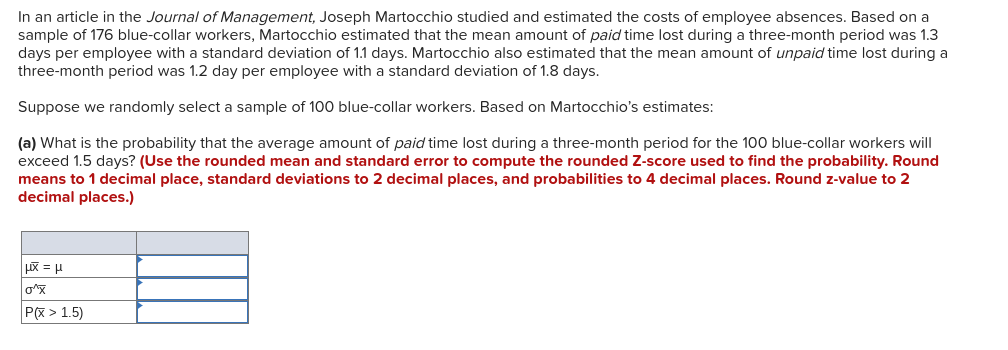In an article in the Journal of Management, Joseph Martocchio studied and estimated the costs of employee absences. Based on a sample of 176 blue-collar workers, Martocchio estimated that the mean amount of paid time lost during a three-month period was 1.3 days per employee with a standard deviation of 1.1 days. Martocchio also estimated that the mean amount of unpaid time lost during a three-month period was 1.2 day per employee with a standard deviation of 1.8 days. Suppose we randomly select a sample of 100 blue-collar workers. Based on Martocchio's estimates: (a) What is the probability that the average amount of paid time lost during a three-month period for the 100 blue-collar workers will exceed 1.5 days? (Use the rounded mean and standard error to compute the rounded Z-score used to find the probability. Round means to 1 decimal place, standard deviations to 2 decimal places, and probabilities to 4 decimal places. Round z-value to 2 decimal places.) P(x > 1.5)
In an article in the Journal of Management, Joseph Martocchio studied and estimated the costs of employee absences. Based on a sample of 176 blue-collar workers, Martocchio estimated that the mean amount of paid time lost during a three-month period was 1.3 days per employee with a standard deviation of 1.1 days. Martocchio also estimated that the mean amount of unpaid time lost during a three-month period was 1.2 day per employee with a standard deviation of 1.8 days. Suppose we randomly select a sample of 100 blue-collar workers. Based on Martocchio's estimates: (a) What is the probability that the average amount of paid time lost during a three-month period for the 100 blue-collar workers will exceed 1.5 days? (Use the rounded mean and standard error to compute the rounded Z-score used to find the probability. Round means to 1 decimal place, standard deviations to 2 decimal places, and probabilities to 4 decimal places. Round z-value to 2 decimal places.) P(x > 1.5)
MATLAB: An Introduction with Applications
6th Edition
ISBN:9781119256830
Author:Amos Gilat
Publisher:Amos Gilat
Chapter1: Starting With Matlab
Section: Chapter Questions
Problem 1P
Related questions
Question

Transcribed Image Text:In an article in the Journal of Management, Joseph Martocchio studied and estimated the costs of employee absences. Based on a
sample of 176 blue-collar workers, Martocchio estimated that the mean amount of paid time lost during a three-month period was 1.3
days per employee with a standard deviation of 1.1 days. Martocchio also estimated that the mean amount of unpaid time lost during a
three-month period was 1.2 day per employee with a standard deviation of 1.8 days.
Suppose we randomly select a sample of 100 blue-collar workers. Based on Martocchio's estimates:
(a) What is the probability that the average amount of paid time lost during a three-month period for the 100 blue-collar workers will
exceed 1.5 days? (Use the rounded mean and standard error to compute the rounded Z-score used to find the probability. Round
means to 1 decimal place, standard deviations to 2 decimal places, and probabilities to 4 decimal places. Round z-value to 2
decimal places.)
P(X > 1.5)

Transcribed Image Text:(b) What is the probability that the average amount of unpaid time lost during a three-month period for the 100 blue-collar workers will
exceed 1.5 days? (Use the rounded mean and standard error to compute the rounded Z-score used to find the probability. Round
standard deviations to 2 decimal places and probabilities to 4 decimal places. Round z-value to 2 decimal places.)
P(x > 1.5)
Expert Solution
This question has been solved!
Explore an expertly crafted, step-by-step solution for a thorough understanding of key concepts.
This is a popular solution!
Trending now
This is a popular solution!
Step by step
Solved in 4 steps

Knowledge Booster
Learn more about
Need a deep-dive on the concept behind this application? Look no further. Learn more about this topic, statistics and related others by exploring similar questions and additional content below.Recommended textbooks for you

MATLAB: An Introduction with Applications
Statistics
ISBN:
9781119256830
Author:
Amos Gilat
Publisher:
John Wiley & Sons Inc

Probability and Statistics for Engineering and th…
Statistics
ISBN:
9781305251809
Author:
Jay L. Devore
Publisher:
Cengage Learning

Statistics for The Behavioral Sciences (MindTap C…
Statistics
ISBN:
9781305504912
Author:
Frederick J Gravetter, Larry B. Wallnau
Publisher:
Cengage Learning

MATLAB: An Introduction with Applications
Statistics
ISBN:
9781119256830
Author:
Amos Gilat
Publisher:
John Wiley & Sons Inc

Probability and Statistics for Engineering and th…
Statistics
ISBN:
9781305251809
Author:
Jay L. Devore
Publisher:
Cengage Learning

Statistics for The Behavioral Sciences (MindTap C…
Statistics
ISBN:
9781305504912
Author:
Frederick J Gravetter, Larry B. Wallnau
Publisher:
Cengage Learning

Elementary Statistics: Picturing the World (7th E…
Statistics
ISBN:
9780134683416
Author:
Ron Larson, Betsy Farber
Publisher:
PEARSON

The Basic Practice of Statistics
Statistics
ISBN:
9781319042578
Author:
David S. Moore, William I. Notz, Michael A. Fligner
Publisher:
W. H. Freeman

Introduction to the Practice of Statistics
Statistics
ISBN:
9781319013387
Author:
David S. Moore, George P. McCabe, Bruce A. Craig
Publisher:
W. H. Freeman